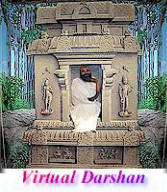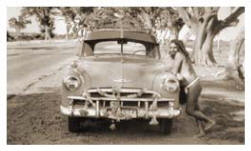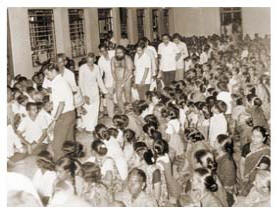|
|
|
During the three decades after his completion of tapas, Shivabalayogi traveled regularly and extensively at the invitation of local devotees. Swamiji conducted meditation and bhajan programs in a seemingly endless list of cities, towns and villages throughout South and North India: Madras, Bombay, Mangalore, Mysore, Jaipur, Delhi, Ambala, Lucknow, Jhansi and Bhubhaneshwar to name only a few of the larger places. He established ashrams in Dodballapur, Bangalore, Sambhar Lake in Rajastan, Dehradun, Anantapur, Hyderabad, Hindupur, Guntur, Venkatapuram and Agra. In the first eighteen years after his tapas, Shivabalayogi undertook seven all-India tours and visited Sri Lanka repeatedly.
There were no rest stops. Afternoons and evenings were packed with programs, and Shri Swamiji would sit with devotees and give darshan late into the night. If there was some free time, Swamiji was likely to ask for a picnic to be organized for the devotees. He visited temples to bless the deities. He visited homes where devotees ceremonially bathed his feet. He consecrated the foundations of countless temples, homes and businesses. He made himself endlessly available to devotees, both the sincere and those whose primary motives seemed to be material or social status.
|
 |
|
His Life |
| birth |
| childhood |
| childhood stories |
| enlightenment |
| beginning tapas |
| early obstacles |
| four directions |
| tapas completion |
| Adivarapupeta |
|
Ardhanarishwara Linga & Devi |
| India travels |
|
Banagalore ashram temple |
| Adivarapupeta ashram |
| in the West |
| mahasamadhi |
|
|
| yogi |
| religions |
| spiritual leaders |
| Jesus & Buddha |
| God |
| forms of God |
| guru-devotee |
| Swamiji's mission |
| initiation, vibhuti |
| meditation |
| samadhi (enlightenment) |
| tapas & Self realization |
| bhajans(devotional song) |
|
bhava samadhi (spiritual trance) |
| world conditions |
| foundation |
| Swamiji's words |
| Virtual Darshan |
|
|
|
Shri Shivabalayogi Maharaj
International Trust P.O. Box 293 Langley, WA 98260 U.S.A. info@Shiva.Org |
 Typically
yogis remain in one place, generally little known until their last physical
years. It is the devotee who must travel to the yogi for darshan. Swamiji
would say that after the yogi takes mahasamadhi, the yogis’ disciples do the
traveling, having received blessings, powers and instructions to go into the
world. This pattern repeated itself in the West when Ramakrishna sent
Vivekananda, when Sri Yukteswar sent Yogananda, and when Nityananda sent
Muktananda. With Shivabalayogi, the yogi himself traveled to devotees.
Typically
yogis remain in one place, generally little known until their last physical
years. It is the devotee who must travel to the yogi for darshan. Swamiji
would say that after the yogi takes mahasamadhi, the yogis’ disciples do the
traveling, having received blessings, powers and instructions to go into the
world. This pattern repeated itself in the West when Ramakrishna sent
Vivekananda, when Sri Yukteswar sent Yogananda, and when Nityananda sent
Muktananda. With Shivabalayogi, the yogi himself traveled to devotees. Everywhere
he gave meditation programs. He would visit a place and give initiation to
large numbers of people, morning, afternoon, and evening, each meditation
period being about one hour. He would sit in samadhi and meditate with the
people sitting in front of him. In the evening there were bhajans followed
by an announcement that if people had anything to ask Swamiji, they could go
up and ask. People brought Swamiji every problem imaginable. He gave each a
patient hearing and he typically put some vibhuti on a tray and made as if
blowing on it. He would then give the vibhuti to the devotee with
instructions on its use: perhaps drink it with warm water, keep it on the
person, wear some between the eyebrows, or rub it on the affected body part.
All were welcome to receive his darshan, and he never permitted anyone to
charge money.
Everywhere
he gave meditation programs. He would visit a place and give initiation to
large numbers of people, morning, afternoon, and evening, each meditation
period being about one hour. He would sit in samadhi and meditate with the
people sitting in front of him. In the evening there were bhajans followed
by an announcement that if people had anything to ask Swamiji, they could go
up and ask. People brought Swamiji every problem imaginable. He gave each a
patient hearing and he typically put some vibhuti on a tray and made as if
blowing on it. He would then give the vibhuti to the devotee with
instructions on its use: perhaps drink it with warm water, keep it on the
person, wear some between the eyebrows, or rub it on the affected body part.
All were welcome to receive his darshan, and he never permitted anyone to
charge money.